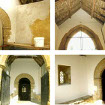There are two principal reasons for using lime plaster, these being efficient moisture release and also the aesthetic and material conservation of historic buildings.
Moisture release.
Lime plaster allows the building to breath. With damp being a potential problem within the fabric of a historic building it is important not to inhibit the release of moisture to the atmosphere.
Cement based plaster does not allow moisture release to the same extent as lime, and gypsum plaster is mildly water soluble, making it unsuitable for environments where moisture is present.
Due to the prevalent use of wood in historic buildings lowering moisture content through the use of lime plaster can help to retard the decay associated with damp wood. Lime plaster allows the inside of stud partitions and ceiling voids to dry. Also, perhaps less obviously, it also allows structural wood that is bedded into walls and plastered over to breathe.
The use of lime plaster is particularly useful on the ground floor in older buildings where no damp proofing provision has been made and the tendency is for water to wick upwards from the soil.
Aesthetic and Conservation Considerations.
Putting aside the legal responsibilities to replace materials like with like when owning a listed building, there are other factors in the decision to use lime plastering.
Particularly regarding historic ceilings and stud partitions there tends to be an organic quality to their appearance and form. This is not matched by the use of plasterboard, which is designed for use on a very uniform basis in modern square buildings. Either patching using plasterboard or replacing entire ceilings, rarely, in my opinion, does anything to maintain the feel and appearance of an historic building. It is better to maintain the undulating form of the wood and stonework to maintain the sense of character.
Regarding the historical context, the use of inappropriate or historically inaccurate materials contributes to the deterioration of the buildings integrity. Admittedly, taken in isolation, the replacement of a single ceiling with plasterboard does not ruin a building in an instant. However, it does contribute to an erosion of historical significance when added to the other modifications that tend to occur to buildings over time. So, if a choice can be taken to restore the lime plaster it is a kinder choice to make.



